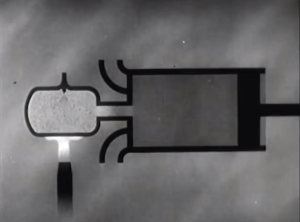The diesel engine was, like many things, born of necessity. The main engine types of the day—hot bulb oil, steam, coal gas, and gasoline—were not so thermally efficient or ideal for doing heavy-duty work like driving large-scale electrical generators. But how did the diesel engine come about? Settle in and watch the 1952 documentary “The Diesel Story“, produced by Shell Oil.
The diesel engine is founded on the principle of internal combustion. Throughout the Industrial Age, technology was developing at breakneck pace. While steam power was a great boon to many burgeoning industries, engineers wanted to get away from using boilers. The atmospheric gas engine fit the bill, but it simply wasn’t powerful enough to replace the steam engine.
 By 1877, [Nikolaus Otto] had completed work on his coal gas engine built on four-stroke theory. This was the first really useful internal combustion engine and the precursor of modern four-stroke engines. It was eventually adapted for transportation with gasoline fuel. In 1890, the hot bulb oil engine was developed under the name Hornsby-Akroyd and primarily used in stationary power plants. Their flywheels had to be started manually, but once the engine was going, the bulb that drove combustion required no further heating.
By 1877, [Nikolaus Otto] had completed work on his coal gas engine built on four-stroke theory. This was the first really useful internal combustion engine and the precursor of modern four-stroke engines. It was eventually adapted for transportation with gasoline fuel. In 1890, the hot bulb oil engine was developed under the name Hornsby-Akroyd and primarily used in stationary power plants. Their flywheels had to be started manually, but once the engine was going, the bulb that drove combustion required no further heating.











